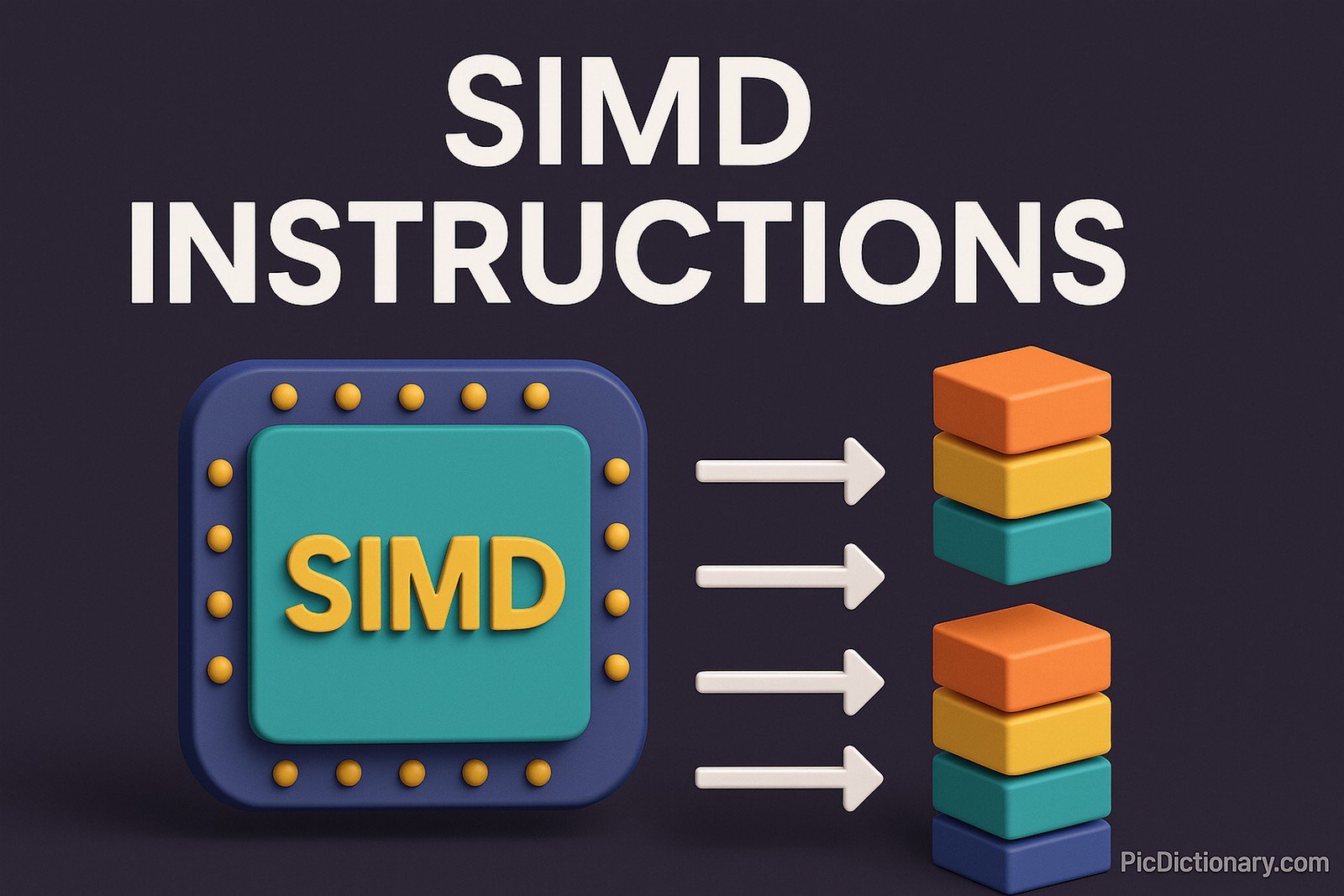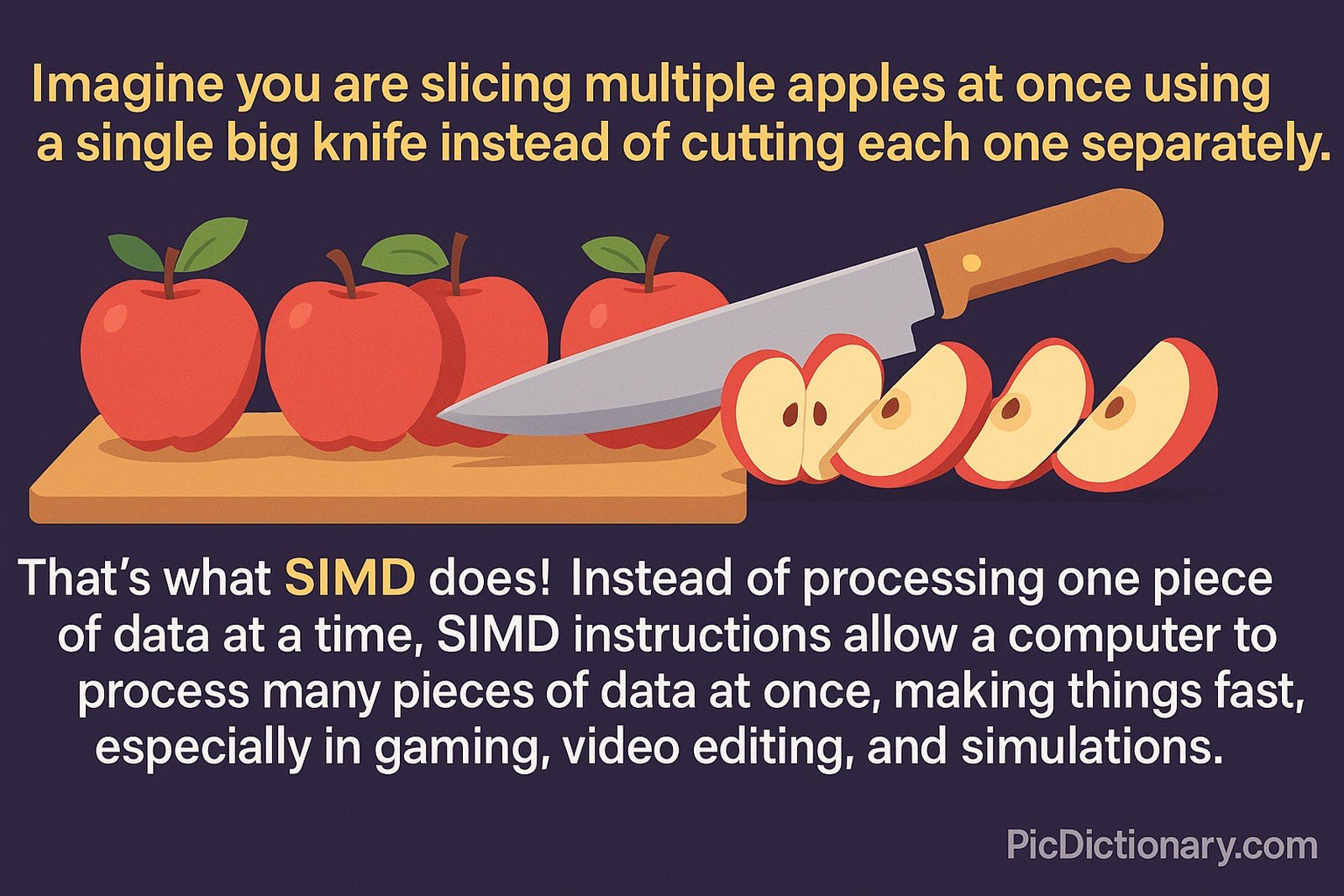SIMD Instructions

Quick Navigation:
- SIMD Instructions Definition
- SIMD Instructions Explained Easy
- SIMD Instructions Origin
- SIMD Instructions Etymology
- SIMD Instructions Usage Trends
- SIMD Instructions Usage
- SIMD Instructions Examples in Context
- SIMD Instructions FAQ
- SIMD Instructions Related Words
SIMD Instructions Definition
SIMD (Single Instruction, Multiple Data) instructions are a class of parallel processing instructions that allow a single operation to be performed on multiple data points simultaneously. These instructions are commonly used in CPUs and GPUs to accelerate performance in tasks like graphics processing, scientific computations, and artificial intelligence workloads. SIMD enables efficient data-level parallelism, improving speed and reducing computational overhead in multimedia and vector-processing applications.
SIMD Instructions Explained Easy
Imagine you are slicing multiple apples at once using a single big knife instead of cutting each one separately. That’s what SIMD does! Instead of processing one piece of data at a time, SIMD instructions allow a computer to process many pieces of data at once, making things faster, especially in gaming, video editing, and simulations.
SIMD Instructions Origin
The concept of SIMD first appeared in early vector processors from the 1960s, such as the IBM 7030 Stretch. SIMD gained widespread use in the 1990s when Intel introduced MMX technology in its processors, followed by SSE, AVX, and other extensions. These advancements significantly improved multimedia processing and computational tasks.
SIMD Instructions Etymology
The term “SIMD” is derived from computer architecture classifications, where "Single Instruction" refers to one operation being executed and "Multiple Data" means applying it to several values at once.
SIMD Instructions Usage Trends
SIMD has become increasingly important with the rise of high-performance computing. Modern CPUs and GPUs incorporate extensive SIMD capabilities to accelerate workloads like deep learning, scientific simulations, and gaming physics. The evolution of SIMD has led to powerful instruction sets such as AVX-512, making parallel computing more efficient.
SIMD Instructions Usage
- Formal/Technical Tagging:
- Parallel Computing
- Vector Processing
- Multimedia Processing - Typical Collocations:
- "SIMD vectorization"
- "SIMD optimized algorithms"
- "SIMD parallel processing"
- "SIMD-based computation"
SIMD Instructions Examples in Context
- Game engines use SIMD to process multiple pixels at once, making graphics rendering smoother.
- Scientific simulations leverage SIMD to perform large-scale numerical calculations efficiently.
- Video encoding and decoding software utilize SIMD to speed up processing times.
SIMD Instructions FAQ
- What are SIMD instructions used for?
SIMD instructions accelerate parallel computations in multimedia, gaming, and scientific applications. - How do SIMD instructions differ from regular instructions?
Regular instructions operate on one data element at a time, whereas SIMD processes multiple data elements simultaneously. - Which processors support SIMD instructions?
Most modern CPUs and GPUs, including Intel, AMD, and ARM architectures, support SIMD extensions. - What are common SIMD instruction sets?
Examples include MMX, SSE, AVX, and ARM NEON. - Why is SIMD important in gaming?
SIMD speeds up graphics rendering and physics calculations, improving game performance. - How does SIMD benefit artificial intelligence?
SIMD enhances neural network computations by accelerating matrix multiplications. - Can SIMD improve battery life in mobile devices?
Yes, by making processing more efficient, SIMD reduces power consumption. - What’s the difference between SIMD and multi-threading?
SIMD processes multiple data points with a single instruction, whereas multi-threading runs different instructions in parallel. - How do developers optimize software for SIMD?
By using compiler intrinsics, vectorized libraries, and SIMD-aware algorithms. - Is SIMD used in cryptography?
Yes, SIMD accelerates encryption and decryption processes.

SIMD Instructions Related Words
- Categories/Topics:
- Parallel Computing
- Computer Architecture
- High-Performance Computing
Did you know?
In 1997, Intel introduced MMX (MultiMedia eXtensions), one of the first SIMD instruction sets for consumer CPUs. This innovation boosted multimedia performance and laid the groundwork for modern SIMD technologies like AVX and NEON.
PicDictionary.com is an online dictionary in pictures. If you have questions or suggestions, please reach out to us on WhatsApp or Twitter.Authors | Arjun Vishnu | @ArjunAndVishnu

I am Vishnu. I like AI, Linux, Single Board Computers, and Cloud Computing. I create the web & video content, and I also write for popular websites.
My younger brother, Arjun handles image & video editing. Together, we run a YouTube Channel that's focused on reviewing gadgets and explaining technology.



Comments powered by CComment